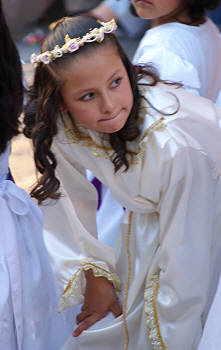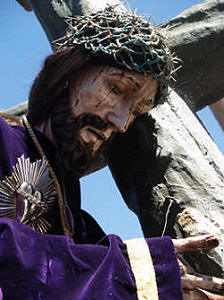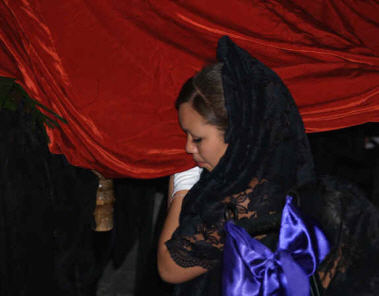The Events of Holy Week in
San Miguel de Allende
Good Friday: The Holiest
& Most Solemn Day of the Year
O f all the events of Holy Week in San Miguel de Allende, Good Friday is the most solemn, the most awe-inspiring, the most profound.
If you have only one day to be in San Miguel and want to truly experience the spirit of her people, this is the day to do it. It is the pinnacle of religious observances and the high point of Semana Santa in San Miguel.
The church bells of San Miguel that joyously or raucously ring for every hour and every occasion throughout the rest of the year will today be silent. Businesses will be closed. It will seem like at least half the town—and much of the rest of the country besides—has gathered in the Jardín to witness the solemn spectacle. Of all the events of Holy Week, this day is the most important.
The Trial of Christ and the Encounter with His Mother

The first important ceremony of the day is the trial and sentencing of Christ before Pontius Pilate. It takes place in the courtyard of the Parroquia and Church of Santa Escuela. Roman soldiers accompany a status of Christ from the church and the charges against him are read. As the trial continues and Pilate washes his hands, the crowd cries "Guilty!"
Now the procession begins. First out is a beautiful statue of Mary as the Virgin of Sorrows. As she is carried around the square by several women, the long purple velvet train of her robe billows out behind her.
The ubiquitous angelitos, little girls in white dresses and angel wings that are part of every Holy Week procession, follow, strewing chamomile onto the pavement as they pass.
These and other figures lead into the emergence of one of the most beloved statues in San Miguel de Allende, an extremely bloody and bowed Christ, who is also known as the "Rain God." This particular statue will be carried from church to church throughout the summer rainy season to insure good water for the crops.
Roman soldiers lead out a man tied up and dressed in a loincloth with whip marks on his back and shoulders. The part is always played by the main priest, exactly as has been done every year since it was started by Father Luis Felipe Neri Alfaro in 1765. He is followed by Romans and penitents dressed in purple sackcloth and crowns of thorns, wearing whips at their waists and carrying skulls in their hands. Some of them drag heavy wooden crosses on their shoulders.
 Finally, another statue emerges from the church; it is Christ bent under the heavy burden of the cross. He is clothed in purple robes with golden trim, his crown of thorns on his head, mounds of flowers at his feet.
Finally, another statue emerges from the church; it is Christ bent under the heavy burden of the cross. He is clothed in purple robes with golden trim, his crown of thorns on his head, mounds of flowers at his feet.
The heavy platforms with their holy figures continue around the Jardín, borne on the shoulders of the faithful. When Mary returns to the Parroquia, her bearers make a three-point turn and back her up to wait at the east corner of the square. Soon, the statue of Christ turns the corner and the two statues are facing each other. They are brought together until only a few yards separate their faces.
A complete hush falls on the crowd as Jesus comes face to face with his mother. It seems as if no one in the crowd is even breathing. And then Jesus lifts his head and looks directly into his mother's eyes.
The statue is cleverly constructed with a mechanism that allows the head to actually move. It is an amazing moment. And no matter how many times you have seen it, when Jesus looks up at his mother, the emotion in the air is palpable. Many people are in tears. You feel the people's religion alive in the streets all around you. Of all the events of Holy week, it is the single most awesome moment.
Insider's Tip: To witness the spectacle for yourself, arrive in the courtyard of the Parroquia around 10 am, no later than 11. If you stand immediately behind the iron fence at the side of the main gate, you'll see the statues emerge and also have a good view of the "Encounter." Wear a hat and sunglasses and be prepared to be crowded. If you show respect for the seriousness of the procession, you will be welcomed.
The Procession of the Holy Burial

The week's most important and profound ceremony is still to come—the Via Dolorosa and Procession of the Holy Burial. It begins at 5 pm, shortly before dusk starts to darken the town, and lasts about two hours. It finishes in darkness, lit only by the dozens of lanterns and hundreds of candles carried by the participants.
The procession has been taking place in San Miguel for nearly 300 years. Today, it's said that more than 2000 people take part. Thousands more line the streets and fill the Jardín to watch it pass. It has the look of a true funeral cortege, with all the men in black suits striped with purple sashes, the women in black dresses, black lace mantillas and white gloves. They carry the brass lanterns and the heavy, beautifully carved statues of the saints through the streets in total silence but for the somber cadence of drumbeats. Occasionally, a voice will ring from one of the balconies along the route, singing a solo "Ave Maria."
The procession begins at the Oratorio, led by a statue of the dying Jesus nailed to the Cross. It winds its way through the streets of Pepe Llanos, Mesones, Juárez, San Francisco on the north side of the Jardín, then turns into Hidalgo, back to Mesones and returns to the Oratorio. Little girls in white dresses with purple sashes carry baskets of rose petals and chamomile sprigs, strewing them onto the cobblestones as they go until the air is heavy with the scent.
Women appear carrying life-sized carvings of the six archangels. Finally, the body of Christ himself, borne by 36 men in black and surrounded by lanterns, begins it sad trip. He lies in a glass casket, its wooden frame elaborately carved and gilded, the bier almost buried in a mountain of flowers. More saints follow, including a beautiful rendition of Our Lady of Solitude.
By the time the cortege makes its way back to Mesones, it is full dark. The entire length of the street glows from the candles and torch lanterns of the pall bearers. In silence and darkness, the procession comes to an end.
The most significant and magnificent of all the events of Holy Week is over.
Tomorrow, Holy Saturday, will be mostly quiet as the world waits—almost hushed with expectation—for the joy of the Resurrection on Easter Sunday, when the events of Holy Week will come to an end.
NOTE: For 2012, Good Friday will be April 6.
NEXT-—Easter Sunday
Return from Events of Holy Week - Good Friday to Semana Santa
BACK to Experience San Miguel HOME
Enjoy this page? Please pay it forward. Here's how...
Would you prefer to share this page with others by linking to it?
- Click on the HTML link code below.
- Copy and paste it, adding a note of your own, into your blog, a Web page, forums, a blog comment,
your Facebook account, or anywhere that someone would find this page valuable.